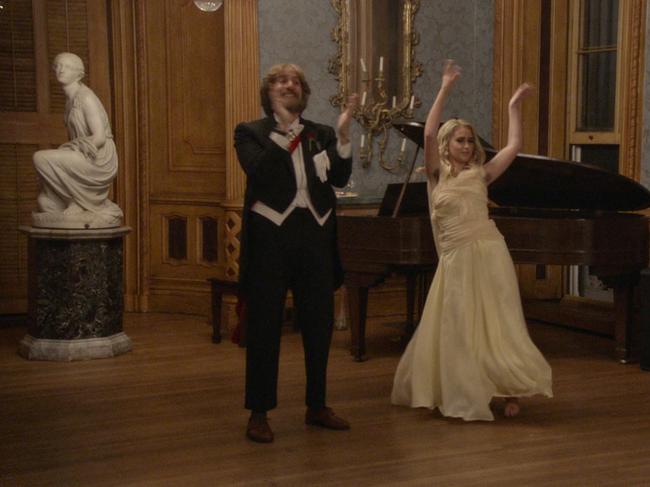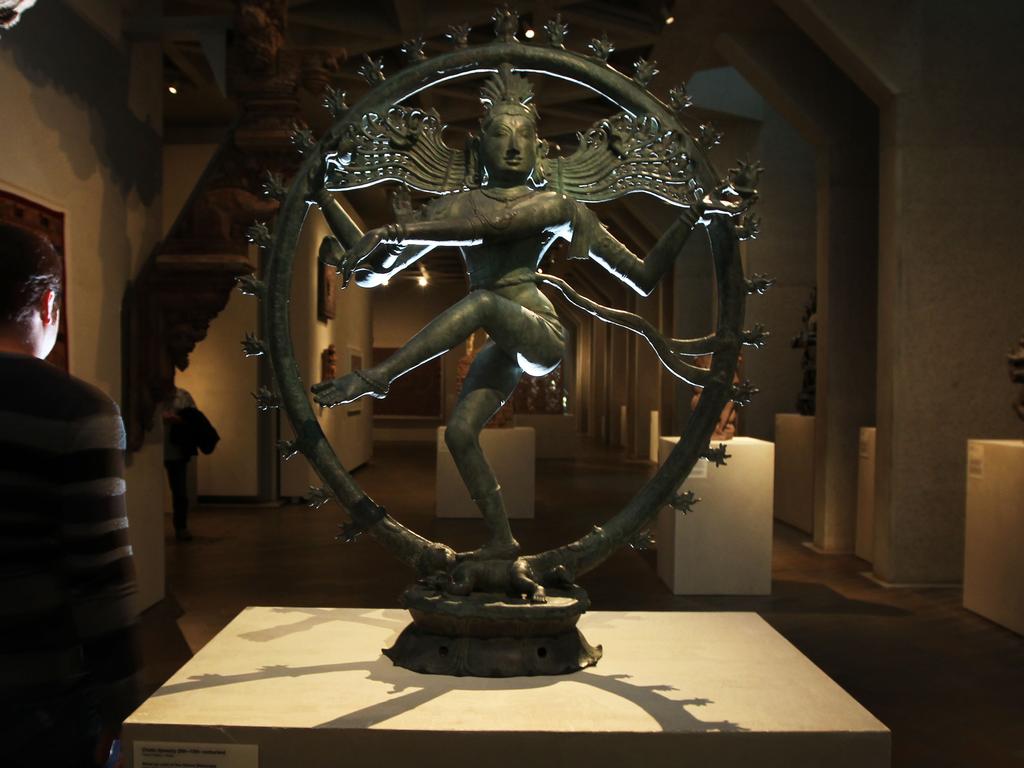
Sacha Baron Cohen’s challenge making a sequel to his 2006 mockumentary Borat: Cultural Learning of America For Make Benefit Glorious Nation of Kazakhstan is that everybody knows the stupid, misogynist, anti-Semitic Kazakh television reporter Borat Sagdiyev.
This becomes apparent early in Borat Subsequent Moviefilm when the grey-suited, curly-haired, moustachioed Borat hits the streets of Manhattan. People rush to greet him and ask for selfies.
Whether they know that Borat is not real, that he is a comedic fake, is another matter.
Baron Cohen solves this by putting Borat in disguise for most of the movie. He wears fat suits, changes his hair, including on his face, and wears different clothes. In a sense this makes this less a mockumentary, more an extended comedy skit.
The question of whether people know they are in a satirical film is still important. If they do, then they’re just acting too. Viewers will make their own calls on this.
A couple of people in the movie or connected to it have complained they were tricked. The relatives of a Holocaust survivor, who has since died, sued on the basis that she was used in the film without her permission. The lawsuit was dismissed.
As it happens, the scene in question is perhaps the only noble one in the 96-minute movie. Borat enters a synagogue dressed as a cartoonish evil Jew. He meets two elderly women, one of whom tells him the Holocaust was real because she was there. What happens next, if the two women do not know they are in a movie, is beautiful.
The action opens with Borat doing a life sentence in the gulag because his previous documentary humiliated Kazakhstan. However, the nation’s leader summons him and hands him a life-or-death mission. He is to return to the US and deliver Kazakhstan’s Minister of Culture “and No.1 porn star” to Vice-President Mike Pence. This gift, or bribe as the extended title puts it, this senior member of the Kazakh regime, is a monkey, literally.
Borat makes it to the US and the delivery crate arrives. Johnny the Monkey is inside, but he’s dead and half eaten. Also inside the crate, and alive and well-fed, is Borat’s 15-year-old daughter Tutar (Bulgarian actress Maria Bakalova, the absolute star of the show).
Borat goes to a shop, faxes his leader (this scene, with the shop owner, is sweetly funny) and receives permission to do a swap and give his daughter, “the oldest unmarried woman in Kazakhstan”, to the “deputy chief puss grabber”.
From here, Turat, used to living in a cage, has to go through a makeover so she can be presented to American society. Eventually, she also starts working as a TV reporter. It’s in this role that she made headlines in the real world, for the scene in which she fake interviews former New York Mayor Rudy Giuliani, a close adviser to Donald Trump, in a hotel room.
What happens, as Giuliani lies on the bed and fiddles with his pants, looks bad. He has offered an explanation. Again, viewers can make up their own minds.
There are other moments, such as Turat in a consultation with a cosmetic surgeon, that retain the sharp sting of the first film, which was directed by Larry Charles, one-time staff writer on Seinfeld. The new director is Jason Woliner, in his feature debut. He has worked on TV shows including Parks and Recreation.
There are hard-to-watch scenes reminiscent of the one in the original where Borat took a bag of human faeces to a dinner party. This time it’s Borat taking his daughter to a debutante ball in Georgia and the two of them performing a Kazakh dance. Here the double-take is achieved: the responses of the other guests show their discomfort with non-Americans and also their over-politeness.
Bakalova is terrific in her first film made outside Bulgaria. It is Turat coming to understand that women shouldn’t live in cages, which changes her relationship with her father, and his response to this, that adds some much-needed emotional depth to what is otherwise a movie that isn’t as funny or as revealing as it thinks it is.
-
Kajillionaire (M)
Selected cinemas
★★★½
Kajillionaire is one of the weirdest films I have seen of late. Written and directed by American filmmaker, author, actor and artist Miranda July, it’s not as out there as Butt Boy, the movie with a literal title I reviewed in May, but it’s out there, and this is a compliment, not a criticism.
Indeed it’s been a while since I have seen a film that after 30 minutes I think is three stars and an hour later I think it is nudging four.
The set-up is simple, but what lies beneath it is complex. Robert (Richard Jenkins), his wife Theresa (three-time Oscar nominee Debra Winger) and their 26-year-old daughter Old Dolio (Evan Rachel Wood, who is amazing) are a family of grifters who live in Los Angeles.
“Old Dolio learned to forge before she learned to write,’’ her father says with a touch of pride.
We first meet them lurking outside a post office. The scam is simple, like all their scams. While her parents keep watch, Old Dolio shimmies towards the post office boxes, avoiding the cameras, opens one, puts her arm inside and steals items from the adjacent PO boxes.
They are after cheques they can cash, or items they can return for a refund. When her father opens one of the packages and finds a tie, his response is oddly funny.
He tells his daughter she doesn’t understand because she “is not of gentle birth’’.
They live in a cheap, dilapidated room next to a factory that makes foam bubbles. Their watches are set for the times of day when they have to scrape foam off their interior wall. They are three months behind in their rent, which sets the scene for what is to come.
“I am happy just to skim,’’ Richard says of their modest incomes. “Most people want to be kajillionaires. That’s how they get you hooked.”
“They”, in short, is the government and its agencies. Richard is a conspiracy theorist. He is also terrified of earthquakes, which is not unreasonable in California. His dour, taciturn wife supports him. With their op-shop clothes and unkempt hair, the family look dodgy.
This only changes when Old Dolio becomes the public face of the grift. She’s the one who dresses in a school uniform and goes to people’s houses to scam them by, say, returning a watch she ‘‘found” in the street and hoping for a reward.
The desperate need to raise the rent leads to a plan to fly to New York and rip off the travel insurance. The scene on the ground in New York is sad to watch and makes us more aware of what is to come. The con job works, more or less. On the flight back, the parents meet an attractive young Hispanic woman, Melanie (Gina Rodriguez), who soon becomes central to their lives.
If this all sounds like a slightly kooky crime comedy, that’s indeed what it is up to this point, and it’s what I was expecting. However, the entrance of Melanie changes everything. The focus shifts to an absorbing exploration of a young woman, Old Dolio, who has been raised without love or affection. When she says her parents are good parents, Melanie asks her to explain why. Old Dolio responds that they always split the proceeds from a scam equally, a third each.
It is from here that we are taken to some strange places. There are two crucial moments that lead to all that will come.
First, Old Dolio attends a parenting class, as part of a scam, and sees a video of a newborn crawling up the mother’s abdomen towards the breast. Soon after, Old Dolio hears her mother call Melanie “hon”. She says she has never called her “hon” and asks her to. Her mother cannot. Her mother tells her, witheringly, that she cannot call her “hon” or “sweetheart” or “baby”. She asks what Old Dolio would expect next: pancakes at breakfast, wrapped birthday presents, or a dance, and at this point she does a little jig.
Two stunning extended scenes follow.
The first, involving Old Dolio and Melanie, starts in a pitch-dark rest room at a service station. That the director is willing to use a black scene for so long is admirable. We then move into blinding light as the two leave the rest room. There are thoughts of death and rebirth here and Evan Rachel Wood is astonishing in her inhabitation of this most unusual character.
The second, involving the whole family and Melanie, takes place at an old man’s house. It’s another scam. The old man is in bed, dying. No kooky crime comedy here.
This is a movie that will keep you guessing until the end, and beyond that point. Who, you will wonder, is scamming who?






Borat Subsequent Moviefilm: Delivery of Prodigious Bribe to American Regime For Make Benefit Once Glorious Nation of Kazakhstan (MA15+)
Amazon Prime
★★½